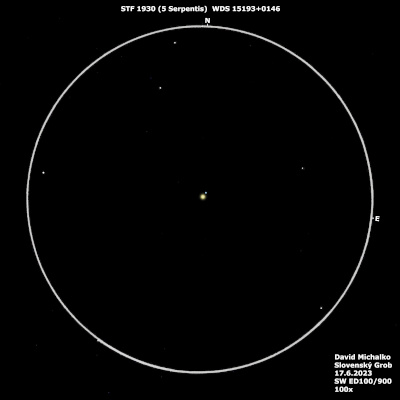Ser
☀5.06/10.11mag
Ø
11''

STF 1930 (5 Serpentis) is a binary system located 83 light-years away from the Sun. The primary component, labeled as A, is a yellow-white main-sequence star of spectral class F8V, with a mass of 1.16 solar masses. Some sources suggest that this star has progressed in its evolution, becoming a subgiant of spectral class F8IV. The companion, labeled as B, is likely an orange main-sequence star of spectral class K4?. Wikipedia notes an estimated orbital period for the AB components of 3371 years, but the reliability of this data is questionable, leaning more towards a common proper motion (CPM) pair.
100mm -STF 1930 is located just under half a degree to the southeast of the beautiful globular cluster M5. Resolving this binary system in a small telescope, given the separation of approximately 11", might seem straightforward, but the 5-magnitude difference between the components can pose a challenge. Under average conditions, the companion appears as a faint, indistinct point with a grayish-blue tint. I observed the primary component as yellow-white, occasionally leaning towards yellow. At lower magnifications, the view includes the M5 globular cluster in the same field of view, providing a delightful sight.